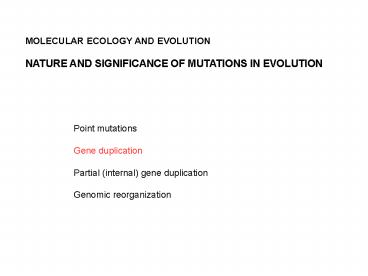MOLECULAR ECOLOGY AND EVOLUTION - PowerPoint PPT Presentation
1 / 20
Title:
MOLECULAR ECOLOGY AND EVOLUTION
Description:
MOLECULAR ECOLOGY AND EVOLUTION. NATURE AND SIGNIFICANCE OF ... Slow loris. Human. Marmoset. 1. 2. 3. 4. 5. 6. 7. 8. Capuchin ~ 35 'genes' Pituitary GH ... – PowerPoint PPT presentation
Number of Views:33
Avg rating:3.0/5.0
Title: MOLECULAR ECOLOGY AND EVOLUTION
1
MOLECULAR ECOLOGY AND EVOLUTION NATURE AND
SIGNIFICANCE OF MUTATIONS IN EVOLUTION
Point mutations Gene duplication Partial
(internal) gene duplication Genomic
reorganization
2
HAEMOGLOBIN
3
Different types of Hb in man HbA ?2?2 HbA2
?2?2 2 of adult Hb ? chain differs from ?
at 10 of residues function (if any)
unclear HbF ?2?2 late foetus and neonate
replaced by HbA 3-6 months after birth ? chain
differs from ??at ????of residues. In presence
of BPG HbF has higher affinity for O2 than HbA,
allowing transfer of O2 to foetus (2 HbFs in man,
g chains differing at 1 aa) HbGower Gower I
?2?2 Embryonic. ? similar to ? (20
differences) Gower II ?2?2 Embryonic.
? similar to ? (40 differences) So, at least 5
different Hbs (6 chains) in normal human. ?, ?,
d, ? chains can all form tetramers, ? can't.
4
DEVELOPMENTAL PATTERN OF HAEMOGLOBIN IN MAN
Based on Voet Voet (1995)
5
TERTIARY STRUCTURE OF MYOGLOBIN AND HAEMOGLOBIN
b? SUBUNIT
6
EVOLUTIONARY TREE RELATING HUMAN GLOBIN CHAINS
7
Hbs in lower organisms Mammals. Adult Hbs all
similar to human HbA, but may be variants unlike
those seen in human. Developmental patterns of
Hbs differ considerably Other vertebrates Most
vertebrates have ?2?2 type structure. Variant
types differ considerably. Lamprey (most
primitive fish) has only a single chain - more
similar to Mb than mammalian Hbs (no
allostery) Invertebrates, plants, bacteria.
Hb-like proteins frequently found, but not ?2?2
8
HAEMOGLOBIN GENE CLUSTERS
Chromosome 16
Chromosome 11
9
MECHANISM OF GENE DUPLICATION
10
CONSEQUENCES OF RECOMBINATION BETWEEN DISPERSED
REPETITIVE DNA ELEMENTS
11
DELETIONS IN THE HUMAN HAEMOGLOBIN b GENE CLUSTER
kbp
b0 thalassaemia Hb Lepore GgAg db
thalassaemia GgAg HPFH Gg HPFH Hb Kenya
HPFH hereditary persistent fetal haemoglobin
12
THE HUMAN GROWTH HORMONE GENE CLUSTER
hGH-N
hPL-L
hPL-A
hGH-V
hPL-B
0
20
40
60
10
30
50
kbp
13
PRIMATE GROWTH HORMONE GENE CLUSTERS
slGH
Slow loris
1
2
3
4
5
6
7
8
Marmoset
Capuchin
35 'genes'
hGH-N
hPL-L
hPL-A
hGH-V
hPL-B
Human
0
20
40
10
30
50
kbp
Pituitary GH
Placental expression
Expressed?
Pseudogene
14
?
Prevertebrate
ILs, GFs etc (cytokines)
Early vertebrate
GH
PRL
Mammals
PLs
PLs
15
(No Transcript)
16
Cytokine receptors
17
MECHANISMS OF GENE DUPLICATION
- Mismatch pairing and recombination (gives
tandem duplicates) - Tetraploidy/polyploidy
- Segmental duplication (duplicative
transposition) (1-100kb) - Retroposition - retropseudogenes - processed
pseudogenes - e.g. mouse alpha globin human cytochrome c
rat insulin - Alu elements
18
- Immediate consequences of gene duplication (fate
of duplicated genes) - One gene may drift until mutations
/substitutions convert it to a pseudogene - Retention. Second gene may be retained because
more expression product required - 3. Subfunctionalization. Both genes deteriorate
slightly, or there is some separation of
functionality, so that they have the same
capacity between them as the original gene. - 4. One gene may drift until mutations/substituti
ons convert it to something usefully different.
19
- Long term consequences of gene duplication
- Provision of second copy (or multiple copies) of
gene where large amounts of transcript required - 2. Forms basis of gene families
- 3. Increase in genome size
- 4. Increase in protein complexity (e.g.
subunits) and subtlety (e.g. enzymes with small
differences in specificity) - 5. Development of completely new functions
20
- BUT sometimes gene duplication may meet a
pre-existing need/opportunity. - e.g.
- A protein already has two functions (e.g. GH in
primates?) - subunits are already associating
- alternative splicing
- colour-sensitive pigment proteins
- snow goose haemoglobin
- multiple hormone receptors































